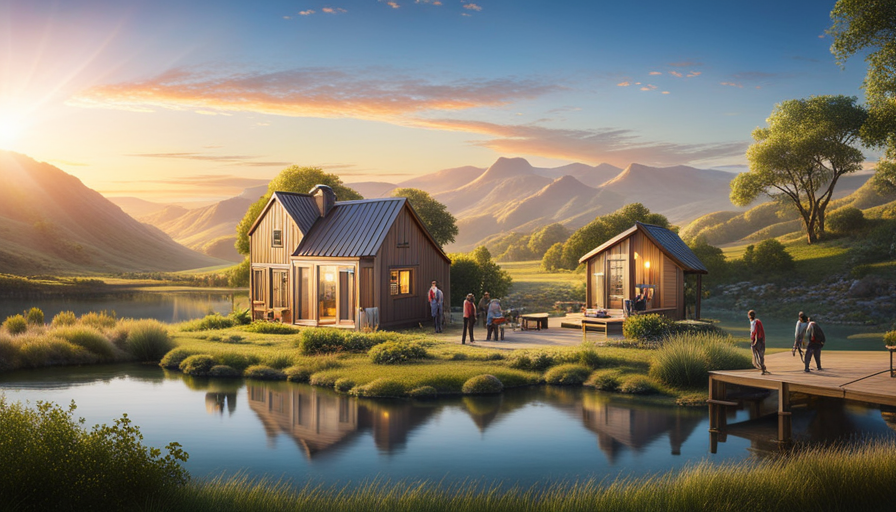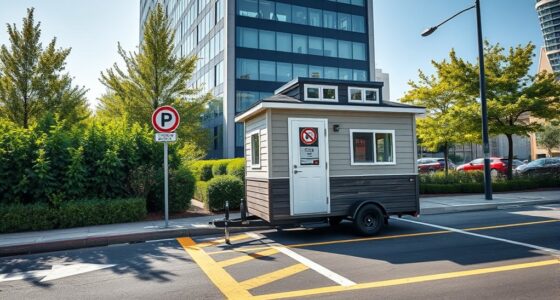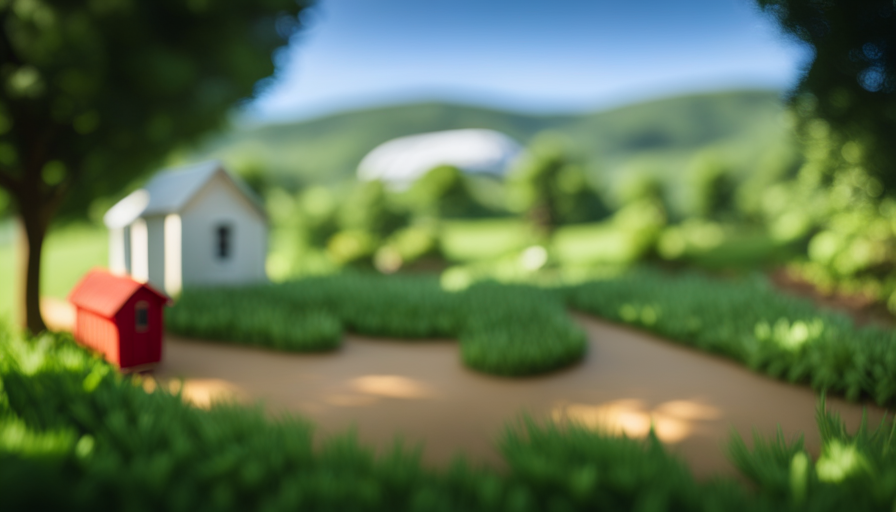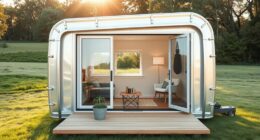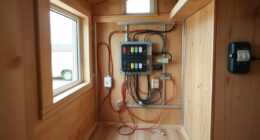Are you prepared to embrace the tiny living lifestyle? Just a heads up, it’s not as simple as you may believe. Finding a piece of land for your tiny home requires careful planning, thorough research, and a wealth of knowledge. But don’t worry, I’m here to guide you through the process.
In this article, I’ll walk you through all the steps you need to take to make your tiny house dreams a reality. From determining your budget and financing options to navigating the complex world of zoning and building regulations, I’ll share my expert advice on how to find the perfect piece of land for your tiny abode.
But wait, there’s more! I’ll also guide you through the process of designing and constructing your tiny house, ensuring it meets all local regulations and maximizing space and functionality. Whether you’re a DIY enthusiast or prefer to hire professionals, I’ll provide you with all the information you need to make the right choices.
So, buckle up and get ready for the adventure of a lifetime. Your tiny house awaits!
Key Takeaways
- Determine budget and financing options
- Research zoning and building regulations in desired location
- Find suitable land through a real estate agent or online listings
- Secure necessary permits and approvals for building and living in a tiny house
Determine your budget and financing options
Figure out how much money you can allocate and explore various financing choices when it comes to buying land for your tiny house.
Determining financing options is crucial in ensuring you make a wise investment. Start by assessing your budget and determining how much you can afford to spend on land. Consider your savings, loans, or even crowdfunding as possible sources of financing.
Additionally, exploring cost-effective alternatives such as owner financing or lease-to-own arrangements can help make buying land more affordable. Research different lenders, compare interest rates, and evaluate loan terms to find the best financing option for your needs.
Once you have determined your budget and financing options, it’s important to research zoning and building regulations in your desired location. This will help you understand any restrictions or requirements you need to comply with when building your tiny house.
Research zoning and building regulations in your desired location
Researching zoning and building regulations in your desired location is essential before you embark on your quest to find the perfect spot for your dream tiny home. It’s important to understand the challenges and legal considerations that come with building a tiny house on a piece of land.
Here are four key things to consider when researching zoning and building regulations:
- Zoning restrictions: Different areas have different zoning regulations that dictate where and how you can build a tiny house. Some areas may have specific zones designated for tiny homes, while others may have restrictions on minimum square footage or require a permanent foundation.
- Building codes: Familiarize yourself with the building codes in your desired location. These codes outline the minimum standards for construction and safety, including requirements for plumbing, electrical systems, and structural integrity.
- Permits and approvals: Determine what permits and approvals are required to build a tiny house. This may include obtaining a building permit, septic system approval, or compliance with environmental regulations.
- Setbacks and utilities: Research setback requirements, which dictate how far your tiny house must be from property lines or existing structures. Additionally, consider access to utilities such as water, electricity, and sewage.
By thoroughly researching zoning and building regulations, you’ll be well-prepared to navigate the challenges and legal considerations associated with building a tiny house on your desired land. Next, let’s explore how to find a real estate agent or browse listings online to find suitable land.
Find a real estate agent or browse listings online to find suitable land
To successfully locate your dream tiny home spot, it’s time to connect with a real estate agent who specializes in unique properties or start perusing online listings.
Working with a real estate agent has several benefits when it comes to finding land for your tiny house. They have extensive knowledge of the local market and can provide valuable insights into zoning regulations and building restrictions in your desired location. Additionally, real estate agents often have access to listings that may not be available to the general public, giving you a wider range of options to choose from.
On the other hand, browsing online listings offers its own advantages. It allows you to conveniently explore different areas and compare prices without the need for face-to-face meetings.
With the help of a real estate agent or by searching online, you can find suitable land that meets your needs and preferences.
Now, let’s consider the size and layout of your tiny house and ensure it meets local regulations.
Consider the size and layout of your tiny house and ensure it meets local regulations
Now that you’ve found potential spots for your dream tiny home, it’s important to consider the size and layout of your cozy abode and make sure it complies with local regulations. When it comes to tiny house design, every inch counts. You need to carefully plan the layout to maximize space and functionality. Consider factors like ceiling height, storage options, and multi-purpose furniture. Additionally, local regulations play a crucial role in determining the size and features of your tiny house. Some areas may have minimum square footage requirements or limitations on the number of bedrooms. It’s essential to research and understand these regulations before finalizing your design. By ensuring your tiny house meets local regulations, you can avoid costly setbacks or potential legal issues. Now, let’s move on to the next step and conduct a thorough land survey and inspection before purchasing.
Conduct a thorough land survey and inspection before purchasing
Before you make any decisions, it’s crucial to thoroughly inspect the land you’re considering and conduct a comprehensive survey to ensure it meets your needs and requirements.
A land survey will help you determine the boundaries, topography, and any potential issues that may affect your tiny house placement.
Additionally, an inspection of the land will reveal any environmental concerns, such as soil quality or drainage problems, that could impact your budget and financing options.
By conducting these assessments, you can avoid costly surprises down the line and make an informed decision about purchasing the land.
Once you have completed the land survey and inspection, you can move on to the next step of securing all necessary permits and approvals for building and living in a tiny house, ensuring a smooth transition into the next phase of your project.
Secure all necessary permits and approvals for building and living in a tiny house
Once you’ve jumped through all the necessary hoops, getting the permits and approvals for your dream tiny home will feel like reaching the peak of a mountain after a grueling climb. The permit process can vary depending on your location, so it’s essential to research and understand the requirements specific to your area. In some cases, you may need to obtain multiple permits, such as a building permit, zoning permit, and septic permit. Additionally, if you plan to live in a tiny house community, you may need to adhere to specific community guidelines and obtain approval from the community association. To help you visualize the permit process, here’s a table outlining some common permits and their purposes:
| Permit | Purpose |
|---|---|
| Building Permit | Ensures your tiny house meets building codes and safety standards |
| Zoning Permit | Verifies that your land is zoned for residential use |
| Septic Permit | Confirms that your sewage system meets health and environmental regulations |
With the necessary permits and approvals in hand, you can move forward and install necessary utilities such as water, electricity, and sewage systems.
Install necessary utilities such as water, electricity, and sewage systems
To fully equip your dream tiny home, you’ll want to ensure the installation of essential utilities like water, electricity, and sewage systems.
When it comes to water system installation, you have a few options. You can connect to a municipal water supply if available, or you can install a well on your property. If you choose the latter, it’s important to check local regulations and obtain any necessary permits.
Additionally, consider incorporating sustainable energy sources into your tiny house. Solar panels can provide electricity, while rainwater collection systems can supply water for non-potable uses. These eco-friendly solutions not only reduce your environmental impact but also offer long-term cost savings.
Now that you have your utilities in place, let’s move on to the exciting task of planning and designing your tiny house to maximize space and functionality.
[Transition sentence]: With the utilities sorted, it’s time to focus on designing a space-efficient and functional tiny house.Plan and design your tiny house to maximize space and functionality
Now that you’ve installed the necessary utilities, it’s time to focus on planning and designing your tiny house. This step is crucial in maximizing storage and optimizing the layout to create a functional and comfortable living space.
As a professional in the field, I can assure you that careful consideration of every inch is essential. Start by envisioning how you want your tiny house to look and feel. Think about your lifestyle and prioritize your needs.
Consider using clever storage solutions such as built-in shelves, hidden compartments, and multi-functional furniture. Don’t be afraid to get creative with your design to make the most of the limited space. Remember, every decision you make should contribute to a seamless and efficient flow within your tiny house.
Now, let’s move on to the next section about hiring professional help or DIY construction depending on your skills and resources.
Hire professional help or DIY construction depending on your skills and resources
Deciding whether to hire professional help or tackle the construction yourself depends on your skills and resources. Hiring professionals can save you time and ensure that the construction is done correctly. They have the expertise and experience to handle any challenges that may arise during the building process. However, it can be costly to hire professionals, and it may limit your ability to customize your tiny house exactly how you want it.
On the other hand, DIY construction allows you to have full control over the design and save money. It can be a rewarding experience, especially if you enjoy hands-on projects. Just keep in mind that it requires time, patience, and a certain level of construction skills. So, carefully consider your capabilities and resources before making a decision.
Once the construction is complete, you can enjoy your new tiny house and embrace the benefits of a minimalist lifestyle.
Enjoy your new tiny house and embrace the benefits of a minimalist lifestyle
Once you settle into your cozy new space, you’ll discover a world of freedom and tranquility that comes with embracing a minimalist lifestyle in your tiny home. Living in a smaller space offers numerous benefits of downsizing, such as reduced expenses, less clutter, and a smaller environmental footprint.
Here are some tips for organizing a small space to maximize its functionality and make the most of your minimalist lifestyle:
- Utilize vertical storage: Install shelves or use hanging organizers to maximize storage space.
- Multi-functional furniture: Invest in furniture that serves multiple purposes, such as a storage ottoman or a fold-out table.
- Declutter regularly: Keep your space tidy by regularly decluttering and getting rid of unnecessary items.
- Create zones: Divide your space into different zones for specific activities, such as a sleeping area, a workspace, and a relaxation area.
- Maximize natural light: Use sheer curtains or blinds to let in as much natural light as possible, making your space feel larger and more open.
Embracing a minimalist lifestyle in your tiny house allows you to simplify your life, reduce stress, and focus on the things that truly matter.
Frequently Asked Questions
How much does it cost to buy land for a tiny house?
The cost of buying land for a tiny house can vary greatly depending on location and size. For example, in a rural area, you may find a plot for $10,000-$50,000. Financing options include traditional mortgages or personal loans. Cost considerations include utilities and permits.
Are there any restrictions on where I can put my tiny house?
There are zoning restrictions and legal considerations when it comes to placing a tiny house. It’s important to research local regulations and building codes to ensure compliance and avoid any legal issues.
What are the common regulations for building a tiny house?
When building a tiny house, it’s important to be aware of common regulations. These can vary by location, but challenges in obtaining permits often include zoning restrictions, minimum square footage requirements, and utility connections.
How do I find available land for my tiny house?
To find land for my tiny house, I should research available properties through online real estate platforms or local listings. It’s essential to consider zoning laws to ensure the land is suitable for my tiny house.
Are there any specific requirements for utilities in a tiny house?
There are specific requirements for utilities in a tiny house, especially if you are considering off-grid living. It is important to plan and install systems for water, electricity, and waste management that are suitable for a tiny house.
Conclusion
In conclusion, buying land to put a tiny house on requires careful planning and consideration. By determining your budget and researching zoning regulations, you can make your dream a reality.
Conducting a thorough land survey and inspection, installing necessary utilities, and designing your tiny house to maximize space are essential steps in the process.
Whether you choose to hire professionals or take on the construction yourself, embracing a minimalist lifestyle in your new tiny house will bring you the freedom and simplicity you desire. As they say, “less is more,” and with a tiny house, you can truly experience the beauty of this idyllic phrase.
I’m Theodore, and I love tiny houses. In fact, I’m the author of Tiny House 43, a book about tiny houses that are also tree houses. I think they’re magical places where imaginations can run wild and adventures are just waiting to happen.
While tree houses are often associated with childhood, they can be the perfect adult retreat. They offer a cozy space to relax and unwind, surrounded by nature. And since they’re typically built on stilts or raised platforms, they offer stunning views that traditional homes simply can’t match.
If you’re looking for a unique and romantic getaway, a tree house tiny house might just be the perfect option.
